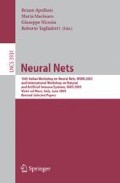Abstract
We propose importing results from monotone game theory to model the evolution of a bacterial population under antibiotic attack. This allows considering the bacterium aging as a relevant phenomenon moving the evolution far away from the usual linear predator-prey paradigms. We obtain an almost nonparametric aging mechanism based on a thresholding operation, as an elementary intelligent operation, that may explain some typical patterns of the population evolution. In this paper we discuss both theoretical aspects and the results of a standardized procedure.
Access this chapter
Tax calculation will be finalised at checkout
Purchases are for personal use only
Preview
Unable to display preview. Download preview PDF.
References
Garrett, S.: Parameter-free, adaptive clonal selection. In: Congress on Evolutionary Computing, CEC. IEEE, Los Alamitos (2004)
Stewart, E., Madden, R., Paul, G., Taddei, F.: Aging and death in an organism that reproduces by morphologically symmetric division. PLoS Biology 3, 295–300 (2005)
Capasso, V.: Mathematical Structures of Epidemic Systems. Springer, New York (1992)
Prikrylova, D., J’ilek, M., Waniewski, J.: Mathematical Modeling of the Immune Response. CRC Press, Boca Raton (1992)
Perelson, A.S.: Modelling viral and immune system dynamics. Nature Rev. Immunol. 2, 28–36 (2002)
McCulloch, W., Pitts, W.: A logical calculus of ideas immanent in nervous activity. Bulletin of Mathematical Biophysics 5, 115–133 (1943)
Castiglione, F.: A network of cellular automata for the simulation of the immune system. International Journal Morden Physics C 10, 677–686 (1999)
Blackwell, D., Girshick, M.A.: Theory of Games and Statistical Decisions. Dover Publications, Inc., New York (1979)
Apolloni, B., Bassis, S., Gaito, S., Malchiodi, D., Zoppis, I.: Facing indeterminacy for winning a monotone game. Information Sciences (2005) (to appear)
Apolloni, B., Bassis, S., Gaito, S., Malchiodi, D.: Cooperative games in a stochastic environment. In: Apolloni, B., Kurfess, F. (eds.) From synapses to rules. Discovering symbolic rules from neural processed data, pp. 75–86. Kluwer Academic/Plenum Publishers, New York (2002)
Tool, B.S.M. (2005), http://laren.usr.dsi.unimi.it/Batteri/index.html
Rumelhart, D.E.: Parallel Distributed Processing, vol. 1. MIT Press, Cambridge (1986)
Wolfram, S.: Theory and Applications of Cellular Automata. World Press (1986)
Ferber, J.: Multi-Agents Systems. Addison Wesley, Reading (1999)
Kleinstein, S.H., Seiden, P.E.: Simulating the immune system. IEEE Computing in Science and Engineering 2, 69–77 (2000)
Gillespie, D.: A general method for numerically simulating the stochastic time evolution of coupled chemical reactions. Journal of Computational Physics 22, 403–434 (1976)
Turner, T., Schnell, S., Burrage, K.: Stochastic approaches for modelling in vivo reactions. Computational Biology and Chemistry 28, 165–178 (2004)
Regev, A., Shapiro, E.: Cells as computation. Nature, 343–419 (2002)
Stoiber, H., Clivio, A., Dierich, M.P.: Role of complement in hiv infection. Annual Review of Immunology 15, 649–674 (1997)
Dierich, M.P., Stoiber, H., Clivio, A.: A complementary aids vaccine. Nature Medicine 2, 153–155 (1996)
Author information
Authors and Affiliations
Editor information
Editors and Affiliations
Rights and permissions
Copyright information
© 2006 Springer-Verlag Berlin Heidelberg
About this paper
Cite this paper
Apolloni, B., Clivio, A., Bassis, S., Gaito, S., Malchiodi, D. (2006). An Evolution Hypothesis of Bacterial Populations. In: Apolloni, B., Marinaro, M., Nicosia, G., Tagliaferri, R. (eds) Neural Nets. WIRN NAIS 2005 2005. Lecture Notes in Computer Science, vol 3931. Springer, Berlin, Heidelberg. https://doi.org/10.1007/11731177_30
Download citation
DOI: https://doi.org/10.1007/11731177_30
Publisher Name: Springer, Berlin, Heidelberg
Print ISBN: 978-3-540-33183-4
Online ISBN: 978-3-540-33184-1
eBook Packages: Computer ScienceComputer Science (R0)

